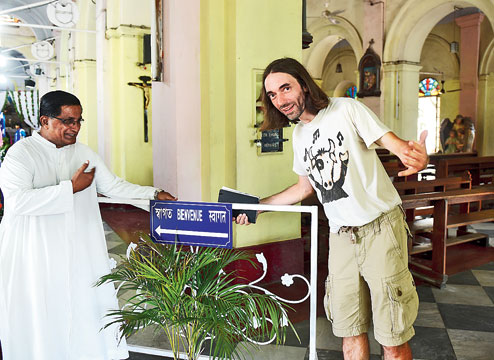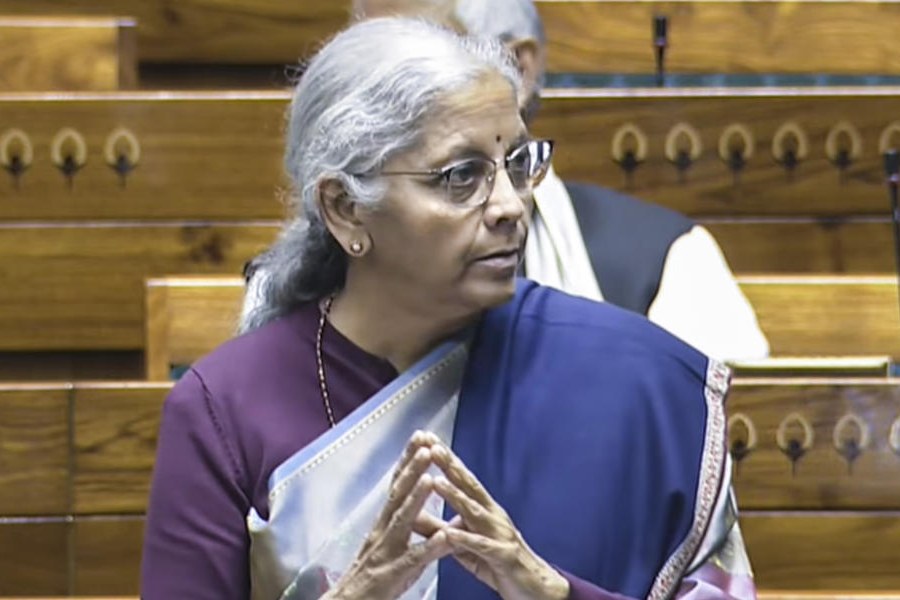French mathematician Cedric Villani set out on Saturday to explore a slice of his country's colonial history in this town on the Hooghly - and met people worried about their town's eroding legacy, losing prominence and changing beauty.
Villani met a priest, a former associate of Mother Teresa, trying to restore a 325-year-old church. He walked across a nursery-garden for flower, fruit and foliage plants whose owner wants the French government's help to protect his home from land sharks. Another local resident whose family has lived here for over 250 years surprised Villani by pulling out a 1905 photograph that he told his visitor is testimony to the "French love for beauty".
THE PRIEST

Villani, in the visitors’ book of the Sacred Heart Church, where he was greeted by a priest named Orson Wells and a sign in French that said “Bienvenue (welcome)” before going click-click at the first French grave (below) in Chandernagore, dating back to 1754

Villani, who won the Fields Medal for mathematics, the equivalent of a Nobel Prize, in 2010 and has visited former French territories in Algeria, Cameroon, Senegal and Vietnam, sandwiched his Chandernagore visit between technical lectures at academic institutions in Calcutta.
The man known as the Lady Gaga of Mathematics returned with more than just new images in his head and his phone camera. He's also caught what could be glimpses of pride coexisting with poignancy among some long-term residents of a town whose historical legacy includes vestiges of the 18th century English-French wars in India.
THE GRANDSON

Nursery owner Gautam Sett (right) to a bewildered Villani, staring at a framed certificate — the Chevalier de la Legion d’Honneur — the French government had bestowed on his grandfather Deshashree Harihar Sett in 1934
"People are as important as the places you travel to, my meetings with the people in Chandernagore were the most important part of the experience," said Villani, who began his tour with a short stroll on the Strand, a tree-lined, paved promenade along the Hooghly. "When you visit historical places and read all the guidance posters there, you learn what happened. But when you meet people, you also get to know how people view their history, and what they are thinking now," he told Metro.
Members of the local community say many French visitors come to the town where France established a trading post in 1673, lost it to the British in the 1757 war, but regained it in 1816 to govern it as part of French territory in India until 1950.
"Some of us are deeply worried about what appears to be apathy towards this town losing its rich legacy, bit by bit," said Basabi Pal, associate professor of French at the Chandernagore Government College. "We need more and more people to come together to campaign for its preservation and restoration."
Pal is among long-term residents concerned at what they believe is the town's changing facade, driven by developers pulling down French-era buildings to make place for new apartment blocks. They also rue what they say is inadequate government funding for maintenance of even certified heritage buildings.
"Some of the old buildings are owned by private families - when they decide to sell to developers, there is nothing that we can do," said Debasis Biswas, the sub-divisional officer and commissioner of the corporation. "The local corporation does not have sufficient funds for adequate maintenance of old structures," he said, adding that while one way to generate funds would be to draw more tourists, that effort by itself would require investments to improve the town's infrastructure.
THE GUIDE

Retired government official Tapan Kumar Chatterjee, whose family has lived in Chandernagore for over 250 years, to Villani during a guided tour of the Chandernagore Institute and Museum. Pictures by Amit Datta
While on the Strand, Villani - a mathematician whose other interests range from movies and music to comics and camping - obliged college students seeking selfies with him. Then, pure chance encounters with three residents drew him into pondering about the town and its people. "You have mixed feelings after a visit to a town like this," he said. "They are a mix of appreciation and nostalgia for what has gone - it is beautiful, but it is also sad."
The Grandson
In a musty ground-floor room of a three-storey mansion built over 150 years ago, Gautam Sett, the nursery owner, nudged Villani to a frame on the wall that displays a certificate - Chevalier de la Legion d'Honneur - the French government had bestowed upon his grandfather, Deshashree Harihar Sett, in 1934.
Sett, who has spent over five years seeking to get his ancestral home declared as a heritage monument, is also struggling to keep it safe from developers. He handed over to Villani a 22-page dossier of documents, among them a letter written by representatives of the Chandernagore Art Theatre to the Hooghly district magistrate in October 2014. The letter highlights the unique architectural style of Sett's ancestral mansion and a plea to protect it from "promoters' evil eyes".
Sett, whose grandfather had during the early decades of the 20th century helped build schools for girls, himself does not speak English. His delivery to a bewildered Villani was in Bengali. But Sett's neighbour translated. "I need help, I hope the French government will help," Sett said.
Among the documents he handed over is a page with a list of luminaries who have visited the Sett mansion - Rabindranath Tagore, Satyendra Nath Bose, Nazrul Islam, Sarat Chandra Chattopadhyay and Syama Prasad Mookerjee. "Important people have come here," he told his latest visitor.
The Guide
At the Chandernagore Institute and Museum, Tapan Kumar Chatterjee, a 70-year old retired government official whose family has lived in this town for over 250 years, offered to guide Villani through the building. In slow but articulate speech, Chatterjee took him through displays of maps, publications, cannonballs used during the British attack on Chandernagore in 1757, books in French and a giant bed that belonged to Joseph Dupleix, the head of the French settlement appointed in 1730.

Villani, high-fiving a young man at the Sacred Heart Church
Chatterjee then took Villani to the Nandadulal Temple, whose roof has a hybrid architecture, part-Indian, part-European. "This was once a town known for its beauty," Chatterjee said. "Wait, I want to show you something," he told his visitor before going into his house facing the temple.
He returned with an old black-and-white photograph, a yellow hue on the paper, but an image of a park with an abundance of well-arranged trees. "This was Mary Park in 1905, look at how beautiful it was. This is what they mean by French love for beauty. Now, it is a barren ground where children play football."
Villani said later: "I was moved by this - I am happy this part of our culture is still recognised here."
The Priest
At the Sacred Heart Church, Villani encountered what he would call a low-probability event. He discovered that the father-in-charge and he shared a connection with Lyon: a fondness for Lyon coffee, and the films of Orson Welles. And the father-in-charge's name? Orson Wells!
Wells' grandfather, Michael Wells, was a soldier in the Royal Artillery who arrived in Bengal in the 1880s, married a Bengali woman and stayed back. Wells, who was a high-school teacher before he became a priest drawing inspiration from the work of Mother Teresa, has spent the past three years trying to restore the church that was built in 1691 and has typical features of French architecture.
He guided Villani through a posters-and-images exhibition that the church had organised over the weekend ahead of the scheduled canonization of Mother Teresa on September 4. He took him to what he said was the first French grave in Chandernagore, a stone tablet on the ground with a date of the year 1754, above the remains of Guillaume Guillaudeu, the city's French administrator at the time.
And through the tour, Wells entertained his visitor with bits of personal history - his transition to priesthood, his travels to Europe and his association with Mother Teresa. He gifted Villani a coffee mug and introduced him to a group of students helping the church during the exhibition.
Villani said goodbye to each student with a high-five. "What a beautiful place, full of history and moral and spiritual strength," he wrote in the church's visitors' book.
Have you ever been to Chandernagore? Tell ttmetro@abpmail.com










